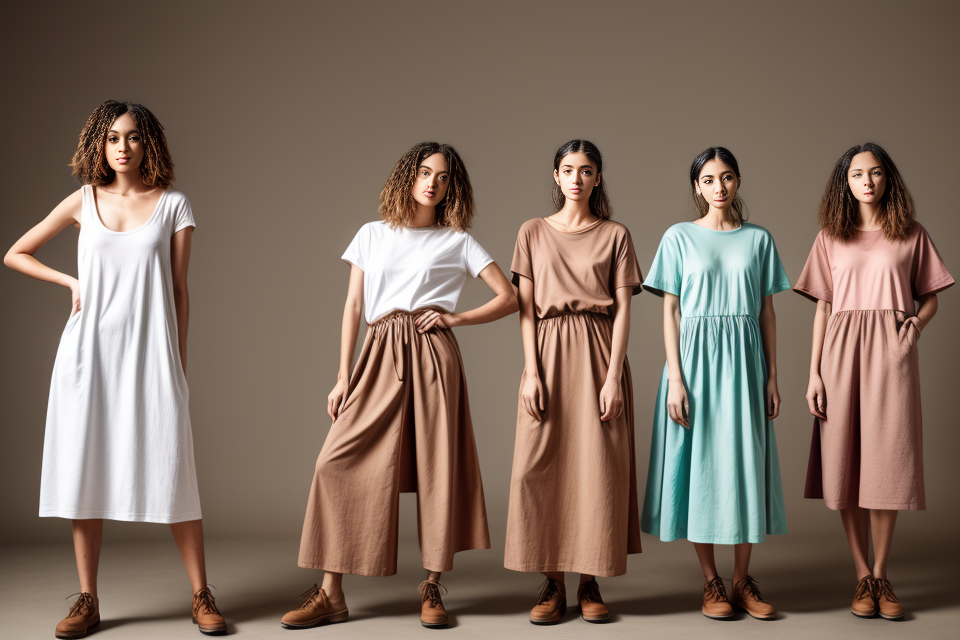
Fashion is a $3 trillion industry that impacts the environment and society in various ways. The growing awareness of sustainability and ethical practices has led to the emergence of two distinct fashion categories: sustainable and ethical fashion. While both categories aim to promote responsible consumption and production, they differ in their approaches and priorities. In this comprehensive guide, we will unpack the difference between sustainable and ethical fashion, exploring their definitions, principles, and impact on the environment and society. We will also discuss the challenges and opportunities in promoting these practices in the fashion industry.
What is Sustainable Fashion?
Key Features
- Environmentally conscious production processes: Sustainable fashion is produced using processes that minimize harm to the environment. This includes reducing water and energy consumption, minimizing the use of harmful chemicals, and ensuring that waste is properly disposed of or recycled.
- Use of eco-friendly materials: Sustainable fashion brands use materials that are environmentally friendly and ethically sourced. This includes organic cotton, recycled polyester, and other materials that have a lower impact on the environment.
- Reduced waste and carbon footprint: Sustainable fashion brands aim to reduce waste by using materials efficiently and designing products that are long-lasting and durable. They also work to reduce their carbon footprint by using renewable energy sources and minimizing transportation emissions.
- Long-lasting and durable clothing: Sustainable fashion brands prioritize quality over quantity, producing clothing that is designed to last. This includes using high-quality materials, investing in good manufacturing practices, and designing clothing that is versatile and timeless. By creating clothing that is built to last, sustainable fashion brands encourage consumers to purchase fewer, higher-quality items that will last for years to come.
Benefits
- Promotes environmental sustainability: Sustainable fashion emphasizes the use of eco-friendly materials and production processes that minimize waste and reduce the environmental impact of the fashion industry. This includes using organic cotton, recycled materials, and other sustainable fabrics, as well as adopting practices such as zero waste and closed loop systems.
- Supports ethical labor practices: Sustainable fashion is also committed to ensuring that workers are treated fairly and ethically throughout the supply chain. This includes paying fair wages, providing safe working conditions, and promoting transparency and accountability in the production process.
- Encourages slow fashion and conscious consumption: Sustainable fashion advocates for a slower, more mindful approach to fashion, encouraging consumers to buy fewer, higher-quality items that will last longer and have a lower environmental impact. This includes promoting the concept of “capsule wardrobes” and encouraging consumers to think critically about their purchasing decisions.
What is Ethical Fashion?
Ethical fashion refers to clothing and accessories that are produced in a manner that adheres to strict standards of social and environmental responsibility. The key features of ethical fashion include:
Responsible sourcing of materials
Ethical fashion brands prioritize the responsible sourcing of materials, ensuring that their raw materials are obtained from sustainable sources. This includes using organic cotton, recycled materials, and other eco-friendly fabrics that minimize the impact on the environment.
Fair labor practices and workers’ rights
Ethical fashion brands are committed to fair labor practices and workers‘ rights. This means that they ensure that their workers are paid a living wage, work in safe and healthy conditions, and are treated with dignity and respect.
Transparency in supply chain and production processes
Ethical fashion brands are transparent about their supply chain and production processes, providing consumers with information about where their products are made, who made them, and how they were made. This level of transparency allows consumers to make informed decisions about the products they purchase.
Social and environmental impact assessments
Ethical fashion brands conduct social and environmental impact assessments to ensure that their products are produced in a manner that minimizes harm to the environment and society. This includes assessing the environmental impact of their products throughout their entire life cycle, from production to disposal, and taking steps to reduce their carbon footprint. They also ensure that their products are produced in a manner that supports local communities and economies.
- Protects workers’ rights and promotes fair labor practices: Ethical fashion ensures that workers are paid a fair wage, work in safe conditions, and have the right to form labor unions. This protects them from exploitation and promotes social justice in the supply chain.
- Reduces negative environmental impacts: Ethical fashion minimizes the harm caused by the fashion industry to the environment. This includes reducing water pollution, minimizing carbon emissions, and conserving resources. By using sustainable materials and practices, ethical fashion minimizes its impact on the environment.
- Builds trust and accountability in the fashion industry: Ethical fashion brands are transparent about their supply chains and production processes. This builds trust with consumers who want to make informed choices about the products they buy. It also promotes accountability, as brands are held responsible for their actions and the impact they have on the environment and society.
Overall, the benefits of ethical fashion are numerous. It promotes social justice, reduces environmental harm, and builds trust and accountability in the fashion industry. By choosing ethical fashion, consumers can make a positive impact on the world while still enjoying stylish and high-quality clothing.
The Intersection of Sustainable and Ethical Fashion
How They Relate
While sustainable and ethical fashion may seem like two distinct concepts, they are, in fact, closely intertwined. Understanding how they relate to one another is crucial for developing a comprehensive understanding of the fashion industry’s sustainability and ethical concerns.
Shared Goals
Both sustainable and ethical fashion share a common goal: minimizing the environmental and social impacts of the fashion industry. This shared objective drives the development of innovative and responsible practices that reduce waste, conserve resources, and promote fair labor standards.
Complementary Approaches
Sustainable and ethical fashion complement each other, as they both aim to create a more sustainable fashion industry. Sustainable practices focus on reducing the environmental footprint of fashion by implementing eco-friendly materials, reducing waste, and conserving resources. Ethical practices, on the other hand, concentrate on ensuring fair labor standards, safe working conditions, and the empowerment of workers, particularly those in developing countries.
By working together, sustainable and ethical fashion can create a more holistic approach to addressing the industry’s environmental and social challenges. By adopting sustainable practices, fashion brands can reduce their environmental impact, while adhering to ethical standards ensures that workers’ rights are respected and protected.
Synergistic Effect
The relationship between sustainable and ethical fashion is synergistic, as both concepts contribute to a more sustainable and ethical fashion industry. Sustainable practices help reduce the industry’s environmental footprint, while ethical practices ensure that workers’ rights are respected and protected.
Moreover, the combination of sustainable and ethical practices can enhance a brand’s reputation, attracting consumers who are increasingly conscious of the environmental and social impacts of their purchases. By adopting both sustainable and ethical practices, fashion brands can differentiate themselves from competitors and appeal to a broader consumer base.
In conclusion, sustainable and ethical fashion share a common goal of minimizing the environmental and social impacts of the fashion industry. By understanding how they relate to one another, fashion brands can adopt complementary practices that create a more sustainable and ethical fashion industry, ultimately benefiting both people and the planet.
Differences
While sustainable and ethical fashion share some common goals, such as reducing environmental impact and promoting social responsibility, they differ in their primary focus and priorities. Here are some key differences between the two:
- Sustainable fashion focuses on environmental sustainability: This approach to fashion prioritizes reducing the environmental impact of the industry, from sourcing eco-friendly materials to minimizing waste and emissions. Sustainable fashion brands may use organic cotton, recycled polyester, and other materials that have a lower carbon footprint and require less water and energy to produce. They may also implement practices such as closed-loop production, where waste materials are repurposed or upcycled, and renewable energy sources, such as solar panels, are used to power factories and offices.
- Ethical fashion emphasizes social responsibility: This approach to fashion prioritizes fair labor practices and worker rights, including paying a living wage, providing safe working conditions, and promoting diversity and inclusion in the workplace. Ethical fashion brands may partner with certified factories and suppliers that meet high standards for labor practices, and they may also support artisanal and small-scale production, which can provide employment opportunities and preserve traditional crafts in communities around the world. They may also advocate for transparency and accountability in the supply chain, and work to address issues such as child labor and forced labor.
Overall, while sustainable and ethical fashion share some common goals, they differ in their primary focus and priorities. Sustainable fashion emphasizes reducing the environmental impact of the industry, while ethical fashion emphasizes social responsibility and fair labor practices. Both approaches are important for creating a more sustainable and equitable fashion industry, and many brands and consumers strive to incorporate elements of both into their practices and purchasing decisions.
Key Differences Between Sustainable and Ethical Fashion
Environmental Sustainability
- Sustainable fashion emphasizes eco-friendly materials and processes
- The use of organic cotton, recycled materials, and innovative technologies to minimize waste and pollution
- A focus on reducing the carbon footprint by adopting renewable energy sources and implementing circular economy principles
- Ethical fashion prioritizes reducing environmental impact through fair labor practices and responsible sourcing
- Ensuring fair wages and safe working conditions for garment workers
- Promoting environmentally conscious manufacturing processes and sustainable supply chains
- Encouraging transparency and accountability in the production process to mitigate the negative effects of fast fashion on the environment
Sustainable fashion places a strong emphasis on using eco-friendly materials and processes to minimize the impact on the environment. This includes the use of organic cotton, recycled materials, and innovative technologies to reduce waste and pollution. By adopting renewable energy sources and implementing circular economy principles, sustainable fashion aims to reduce the carbon footprint and promote a more environmentally conscious approach to fashion.
On the other hand, ethical fashion prioritizes reducing environmental impact through fair labor practices and responsible sourcing. This includes ensuring fair wages and safe working conditions for garment workers, promoting environmentally conscious manufacturing processes and sustainable supply chains, and encouraging transparency and accountability in the production process. By mitigating the negative effects of fast fashion on the environment, ethical fashion aims to create a more sustainable and equitable fashion industry.
Labor Practices
When it comes to labor practices, ethical fashion takes center stage. This subfield of fashion prioritizes fair labor practices and workers’ rights, ensuring that the people involved in the production process are treated with dignity and respect. In contrast, sustainable fashion also considers the environmental impact of the industry, but it may not prioritize labor practices as much as ethical fashion does.
To better understand the differences between sustainable and ethical fashion with regards to labor practices, let’s delve deeper into each subfield:
Ethical Fashion
Ethical fashion is a movement that aims to promote and implement sustainable and socially responsible practices within the fashion industry. It encompasses various aspects, including labor practices, environmental impact, and social responsibility. The main focus of ethical fashion is to ensure that the people involved in the production process are treated fairly and with respect.
One of the key aspects of ethical fashion is fair labor practices. This means that the workers involved in the production process are paid a fair wage, work in safe and healthy conditions, and have their rights protected. Ethical fashion also encourages transparency and accountability, so consumers can be aware of the origins of their clothing and the conditions under which it was produced.
Sustainable Fashion
Sustainable fashion, on the other hand, focuses on reducing the environmental impact of the fashion industry. It aims to minimize waste, reduce energy consumption, and conserve resources. While sustainable fashion also considers labor practices, it may not prioritize them as much as ethical fashion does.
However, it’s important to note that sustainable fashion and ethical fashion are not mutually exclusive. Many sustainable fashion brands also prioritize fair labor practices and workers‘ rights, as they recognize the interconnectedness of environmental and social issues.
In conclusion, while both sustainable and ethical fashion are important movements in the fashion industry, they differ in their focus and priorities. Ethical fashion prioritizes fair labor practices and workers’ rights, while sustainable fashion focuses on reducing the environmental impact of the industry. By understanding these differences, consumers can make informed choices that align with their values and priorities.
Supply Chain Transparency
Supply chain transparency is a critical aspect of both sustainable and ethical fashion. It refers to the visibility and traceability of the production processes, from the sourcing of raw materials to the manufacturing and distribution of finished products. In the context of sustainable and ethical fashion, supply chain transparency is crucial for ensuring that products are produced responsibly and ethically.
- Both sustainable and ethical fashion emphasize transparency in supply chain and production processes:
- Sustainable fashion focuses on minimizing the environmental impact of the production process by using eco-friendly materials and reducing waste. Supply chain transparency in sustainable fashion helps to ensure that the materials used are sustainably sourced and that the production process is environmentally friendly.
- Ethical fashion, on the other hand, emphasizes the ethical treatment of workers and the environment. Supply chain transparency in ethical fashion helps to ensure that workers are paid fairly, working conditions are safe and healthy, and that the environmental impact of the production process is minimized.
- Ethical fashion places a greater emphasis on social and environmental impact assessments:
- Ethical fashion brands often conduct social and environmental impact assessments to ensure that their supply chains are free from exploitation and that they are contributing to a more sustainable future. These assessments may include evaluating the working conditions of factories, assessing the environmental impact of production processes, and ensuring that suppliers are complying with ethical standards.
- Sustainable fashion brands may also conduct such assessments, but the emphasis is typically on minimizing the environmental impact of the production process rather than on social impact.
In summary, while both sustainable and ethical fashion emphasize supply chain transparency, ethical fashion places a greater emphasis on social and environmental impact assessments to ensure that the production process is free from exploitation and that it contributes to a more sustainable future.
FAQs
1. What is sustainable fashion?
Sustainable fashion refers to clothing and accessories that are produced in an environmentally friendly manner, with a focus on reducing the negative impact of the fashion industry on the environment. This includes using eco-friendly materials, reducing water and energy consumption, and minimizing waste. Sustainable fashion brands often prioritize transparency and ethical practices, ensuring that their products are made under fair labor conditions.
2. What is ethical fashion?
Ethical fashion is about ensuring that the people involved in the production of clothing and accessories are treated fairly and with respect. This includes paying a living wage, providing safe working conditions, and promoting gender and racial equality. Ethical fashion brands prioritize transparency and traceability, allowing consumers to understand the supply chain and the conditions under which their products were made.
3. What is the difference between sustainable and ethical fashion?
Sustainable fashion focuses on the environmental impact of the fashion industry, while ethical fashion prioritizes the social and labor conditions of the people involved in the production process. Sustainable fashion brands may use eco-friendly materials and reduce their carbon footprint, while ethical fashion brands ensure that their workers are paid a living wage and work in safe conditions. Both sustainable and ethical fashion aim to create a more responsible and equitable fashion industry.
4. Why is sustainable and ethical fashion important?
Sustainable and ethical fashion is important because the fashion industry has a significant impact on the environment and on the people involved in its production. The fashion industry is responsible for a significant amount of greenhouse gas emissions, water pollution, and waste. Additionally, many fashion workers are underpaid and work in poor conditions. By choosing sustainable and ethical fashion, consumers can make a positive impact on the environment and support fair labor practices.
5. How can I make sustainable and ethical fashion choices?
To make sustainable and ethical fashion choices, look for brands that prioritize transparency and ethical practices. Research the materials used in the products you purchase, and consider the environmental impact of the production process. Look for brands that use eco-friendly materials, reduce waste, and promote fair labor conditions. You can also shop second-hand, upcycle, or repair your clothes to extend their lifespan. By making conscious choices, you can contribute to a more sustainable and ethical fashion industry.

